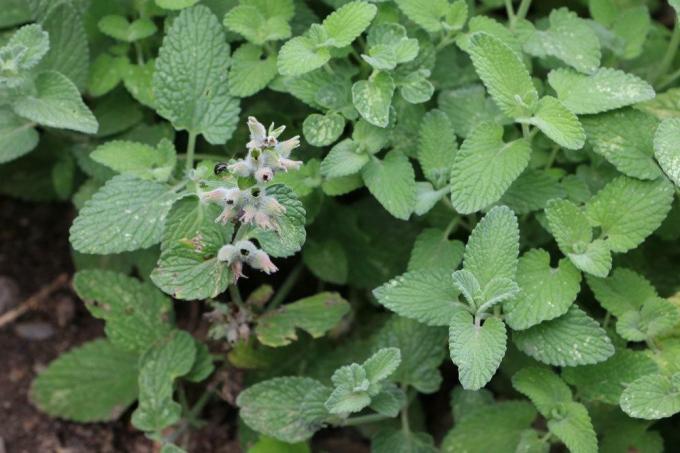
table of contents
- care
- Location
- to water
- Fertilize
- Cut
- Multiply
- Diseases
- Pests
- sorts
Profile and care information open +conclude -
- Flower color
- red, purple, white, blue
- Location
- Partial shade, shady, sunny, full sun
- Heyday
- July August September
- Growth habit
- upright, bushy, perennial, clump-forming, perennial
- height
- up to 100 centimeters high
- Soil type
- sandy, loamy
- Soil moisture
- moderately moist, fresh
- PH value
- neutral, slightly acidic
- Limescale tolerance
- Calcium tolerant
- humus
- rich in humus
- Poisonous
- no
- Plant families
- Mint family, Lamiaceae
- Plant species
- Scented plants, bedding plants, balcony plants, container plants, potted plants
- Garden style
- Pot garden, cottage garden, natural garden, rock garden, flower garden, roof garden, rose garden
Catnip, which beguiles the senses with a lemony, minty smell, creates an oasis of smell in gardens and on balconies. In addition, catnip is a medicinal plant that helps against respiratory diseases and prevents infections with its antibacterial properties. With the right care instructions, the catnip with its colored flowers can fill its surroundings with summer freshness for many years.
care
The catnip (botanical: Nepeta cataria) is not only the ideal plant with a feel-good factor for cat owners for stray four-legged friends, but also inspires plant lovers with its pleasant scent of lemon and mint. The perennial provides a summery ambience in the open air and tastefully decorates, above all, colorless places with its blossoming flowers.
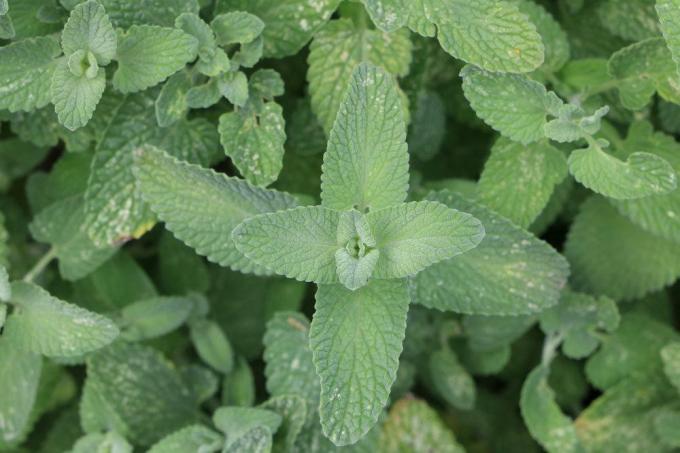
In addition, it is very undemanding in terms of care and can easily be propagated even by flower lovers without a "green thumb". You can find out everything you need to know in the comprehensive care instructions here.
In order to decorate your outdoor area with splendidly thriving flowers every year and to professionally multiply the catnip, you should pay attention to a few details.
Location
The location represents the habitat of the catnip and is jointly responsible for whether the perennial feels comfortable. Since it comes from sunny areas, it also requires this in the local climes. A sunny to full sun location is perfect for this type of plant. Whether planted in a bed, a balcony box or a tub, it doesn't like shade and should be accordingly also do not stand where it reaches little or no sun during the day, as this is essential for its vitality needed.
Soil condition
Another factor for healthy and vigorous growth is the garden soil in which the catnip is planted.
Here you should consider the following criteria for the optimal soil condition:
- nutrient-rich garden soil
- well permeable to water
- sandy to loamy
- relaxed
- salt free
- pH value: around 6.4
- fresh to moderately moist environment
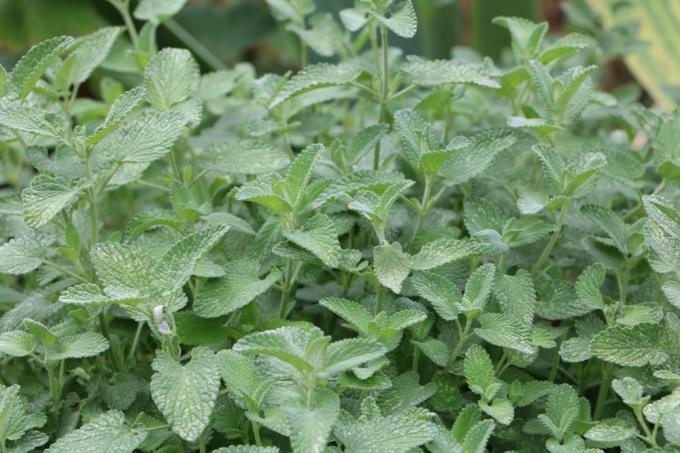
Substrate
A substrate should also meet the same criteria as for the optimal soil quality. Conventional potting soil should be avoided. This hardens over time and becomes increasingly impermeable to water. It is advisable to use a high-quality, nutrient-rich substrate which, if necessary, keeps the substrate looser thanks to a small proportion of peat. A special clay substrate not only provides more strength in the soil, but also stores moisture perfectly.
Planting time
In order for the catnip to develop splendidly in its new destination, it is important to observe the correct planting time.
- preferred catnip: between late April and mid-May
- Catnip sowing: between mid-March to mid-May
Plants in the bed
Once the ideal location for the catnip has been found in the garden bed, planting is imminent.
Here you should proceed as follows:
- plant a planting hole that is twice as deep and wide as the root ball
- observe a minimum planting distance of 30 centimeters
- put about two centimeters of quartz sand or gravel as drainage in the planting hole as the bottom layer
- if necessary, enrich the excavated earth with sand and / or clay
- add peat or compost to the soil for more nutrients
- place the root ball in a container filled with water until no more bubbles appear
- insert the root ball about two centimeters below the surface of the earth
- fill the planting hole with soil and press it down moderately
- then water abundantly, but without provoking waterlogging
- Between three and eight catnips can be planted per square meter
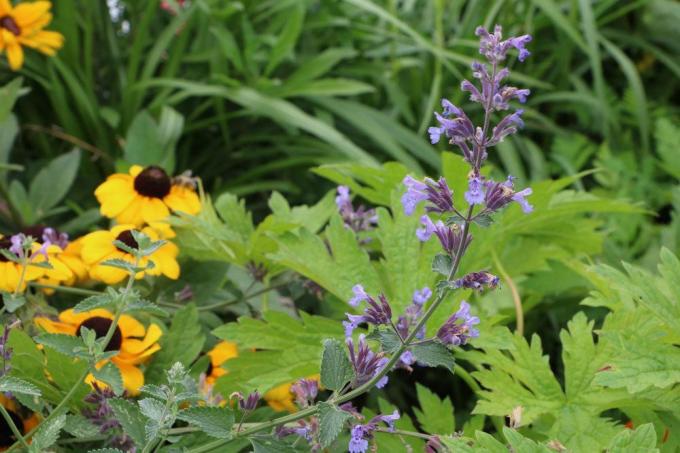
Plants in the pot
Nepeta cataria also looks beautiful in pots and window boxes. Here they can be lined up closer together, as they then develop into a real eye-catcher as an arrangement.
Otherwise, proceed in a similar way to planting in the pot as you would when planting beds. Make sure there is drainage here too, so that waterlogging can be prevented. If you use high-quality substrate, as described under the heading "Substrate", the perennial receives a perfect basis for a healthy, long life.
to water
A loamy and / or sandy soil keeps the moisture in the soil for a long time, especially since the water requirement of the catnip is low. This way, it copes well with dry spells and only needs to be watered occasionally.

The ideal time to pour is when you can no longer press in the surface of the earth with your finger. Water little so that the catnip is not too damp. If you forget to water or are prevented from doing so, the perennial can do without watering for a while, even in hot temperatures.
Fertilize
This perennial does not have to be fertilized additionally. If you still want to do something good for her, you can work some compost or peat into the soil twice a year. A special bloom fertilizer can be given to the cat balm before the blooming season begins, around the end of May, in order to strengthen the bloom formation.
Cut
Regular cutting is advisable to keep them in the desired shape and to encourage their growth.
When cutting, refer to the following details:
- Spring: topiary
- Summer: shorten a few centimeters after flowering to get a second flowering well into autumn
- Late autumn: cut back the stems
- Young or self-grown plants should be cut back a lot in the first year

When pruning in late autumn, make sure that there is no frost. In addition, select a rain-free day so that the interfaces of the stems dry off better and no bacteria are washed into them by the rainwater. Or seal the interfaces with sulfur powder.
Overwinter
Although catnip prefers the warm sun, it can handle cold winter temperatures and frost extremely well. Special measures do not have to be taken for bedding plants for overwintering. If you want to be on the safe side, you can cover the surface of the earth with leaves, straw or pine needles.
However, balcony and container plants are a little sensitive to extreme cold. They should be positioned at least sheltered from the wind. Buckets are to be placed on styrofoam or similar material with insulating properties. Placing in warmer rooms is ideal, however. Here you should make sure that Nepeta cataria is not exposed to extreme temperature differences.
Cool hallways or basement rooms with daylight are ideal for wintering, so that the catnip receives sufficient light even in winter. If you want to put them in heated rooms, either bring the cat balm in early before winter or gradually get used to the increase in temperature.
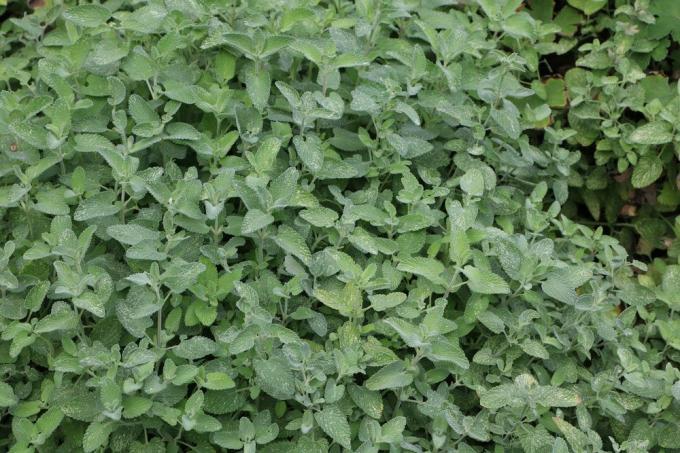
If you have only planted cuttings late in the year, they should be brought into the house before the ground freezes. Catnips are typically not watered outdoors during the winter months. If they are warmer in a room, the degree of dryness of the earth should be checked every now and then and then watered a little if necessary.
Multiply
As a rule, the real catnips self-inseminate and they spread as wild growth in the garden. However, if you want to take over the propagation yourself, you have three options to choose from.
sowing
For sowing, you need seeds, which you can either get in gardening shops or take from the so-called Klaus fruits of the flowers. There are usually four seeds each.
Then proceed as follows for sowing:
- Bag seeds are already pre-dried - you have to let seeds you have collected yourself dry for a few weeks
- fill a small pot or a growing box with a nutrient-poor substrate or special growing soil
- the pH should not be above 7.0
- press the seeds only minimally into the soil and put so much soil over them that they are only lightly covered
- spray the surface of the earth with lime-free water so that it is moderately moist
- now stretch a transparent plastic film over it
- keep the substrate evenly moist
- Germination temperature: 20 degrees Celsius
- Location: full sun
- Germination time: around three to four weeks
- after germination, remove the plastic film
- From a size of five centimeters, the young plants must be transplanted
- they can only be planted outdoors after the ice saints, when no more ground frost is to be expected

division
It is very easy to multiply by dividing the root ball, which also means that the perennial can then develop more vigorously again. Therefore, a root division is generally recommended every three to years.
To do this, cut the root ball of an adult catnip in the middle with a sharp knife or spade. Now plant them as already described under the heading "Plants in the bed". Do not forget to immerse the divided root ball in water for so long before planting until no more bubbles rise, so there is an optimal moisture content for good growth is. The division should take place early in spring or autumn.
Cuttings
Propagation can also be done quickly with cuttings, which is why this is one of the most common methods.
This is how it's done:
- cut off a shoot seven centimeters to ten centimeters long
- remove the bottom leaves
- place the cutting in a container filled with lime-free water, such as a glass
- change the water every two days
- alternatively, you can put the cutting in a pot with a nutrient-poor substrate
- keep the substrate evenly moist
- Location: sunny to full sun
- Temperature: between 20 degrees Celsius and 25 degrees Celsius
- once the first roots have formed, the cutting should be pricked out in a pot
- if it develops vigorously, it can be planted outdoors
- note that cuttings cannot tolerate frost and must overwinter in a warmer place
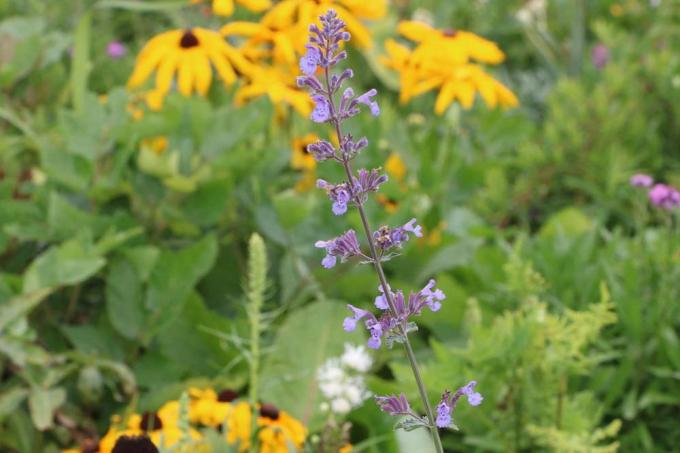
Diseases
The catnip is considered robust, but it is not armed against everything.
mildew
Occasionally the perennial gets sick with powdery mildew, especially if it is exposed to strong temperature fluctuations. This can be recognized by its white coating, which it mainly lays on or under the leaf sides. You can effectively counter this with soapy water that you use to wipe the leaves off. Treatment with strong fungicides is usually not necessary here.
Root rot
If waterlogging has formed or if you mean too well with watering, this usually results in root rot. You can recognize this by the decreasing stability of the stems and a musty smell emanating from the roots.
Dig up the root and cut off the parts of the root that are already showing mold growth and / or have a very soft structure. Ideally, you shorten the entire root in length so that the catnip has more strength when it comes to replanting.
Now put the perennials down for a day or two at a warm temperature so that the last remaining moisture dries off. Then plant the cat balm again in fresh soil or new substrate. This should fix the root rot.

Pests
The leaves and stems of Nepeta cataria contain the active ingredient nepetalactone, which keeps pests away. That is why the catnip is often placed between other plants so that aphids or fleas, for example, stay far away. There is only one pest that cannot be deterred by nepetalactone.
Snails
Snails can cause immense damage and even cause the plant to die. Classic means that are supposed to prevent snails from reaching a plant, such as beer traps or snail fences, usually do not help.
Basically, you can only act effectively against the pests by distributing slug pellets. Early spring between March and April is ideal for spreading slug pellets, when the food supply for the slugs is still poor. They then use the slug pellets, die and then have to be picked up.
Another option is to place special attractant scents to distract from the plants preferred by snails. While this is the more humane method compared to slug pellets, it is not as effective.
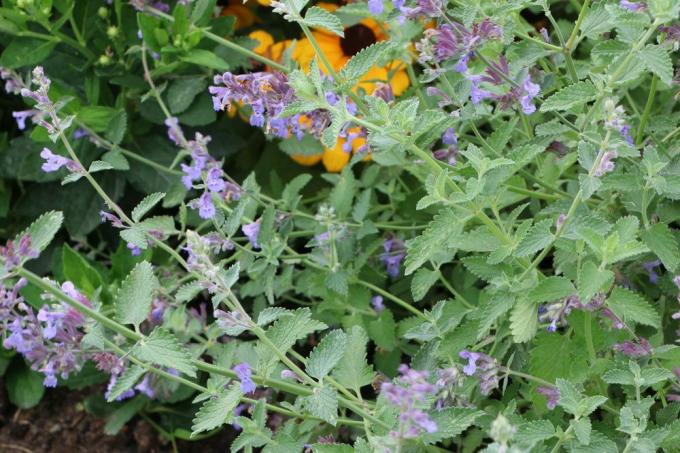
sorts
Around 250 different types of catnip are currently known, which differ both in height and in flower color, such as the following.
Nepeta grandiflora
- has numerous varieties that reach a height of up to 140 centimeters and inspire with flowers in blue-violet, pink or violet-pink
Nepeta nervosa "Kashmir"
- shows up in light blue
Nepeta nuda
- it is a very upright perennial with white flowers
Grape catnip (Nepeta racemosa)
- impresses with an intense lemon scent and is perfect as a border planting due to its lower height
Glacier ice species (Nepeta x faassenii)
- presents itself silvery blue and as an early bloomer



